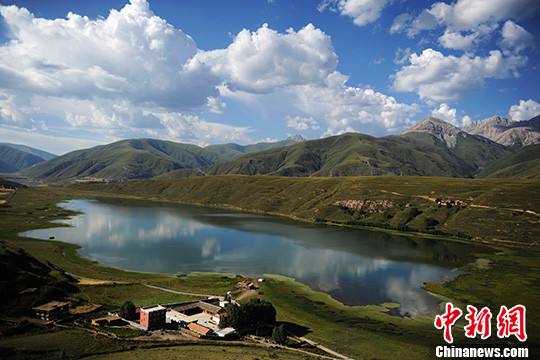

 |
The Qinghai-Tibet Plateau has become warmer and more humid because of increasing amounts of precipitation, said Liu Baokang, senior engineer at Qinghai Institute of Meteorological Science.
Compared with the same period a decade ago, Qinghai Lake in Qinghai province, China’s largest inland salt lake, has expanded 108.18 square kilometers, the highest in the past 17 years.
In early May, a rare rainfall hit the province. According to Dai Sheng, senior engineer at Qinghai Climate Center, the temperature and humidity of the plateau started increasing at the beginning of the 21st century, and the precipitation in May was caused by this increase.
Qinghai Lake is an important water source that secures the ecology of the northeastern part of the Qinghai-Tibet Plateau. It not only prevents the desert from advancing eastward, but also adjusts the region’s climate. The eco-environmental characteristics and the lake’s changes to a great extent reflect variation in the general eco-environment of the plateau.
In addition to the expanding Qinghai Lake, areas of other lakes on the plateau have also increased, including in Hoh Xil. Mr. Liu said that total area of the salt lakes in Hoh Xil stood at 38 square kilometers in 1970s, but increased to 150.41 two years ago.
The Qinghai-Tibet Plateau, a place which used to be cold and dry, is now changing because of global warming. A communiqué on climate change and eco-environment monitoring in Tibet showed that Tibet’s annual surface air temperature has increased by 0.31 degrees Celsius every 10 years in the past give decades, which is higher than the national average.
Rising temperatures and higher precipitation helps expand the vegetation of the region and provides a better living environment. Some experts also believe that the current situation will create favorable conditions for the growth of pasture, increasing the survival rate of livestock cubs.
However, the warming climate will also bring negative effects. Melting permafrost is one of them. The frozen soil in the Qinghai-Tibet Plateau decreased 24 square kilometers in the last 30 years, leading to frequent road damage.
In addition, glaciers in the region are also facing challenges. The glacier area of the plateau decreased 15% in the past three decades. Lake expansion and flooding could increase due to the melting of the ice.
A local expert named Xin Yuanhong believes that rising temperatures and higher humidity in Qinghai-Tibet Plateau are irreversible, and people should take advantage of the opportunities and cope with concomitant challenges to get along with the environment.
 Fire brigade in Shanghai holds group wedding
Fire brigade in Shanghai holds group wedding Tourists enjoy ice sculptures in Datan Town, north China
Tourists enjoy ice sculptures in Datan Town, north China Sunset scenery of Dayan Pagoda in Xi'an
Sunset scenery of Dayan Pagoda in Xi'an Tourists have fun at scenic spot in Nanlong Town, NW China
Tourists have fun at scenic spot in Nanlong Town, NW China Harbin attracts tourists by making best use of ice in winter
Harbin attracts tourists by making best use of ice in winter In pics: FIS Alpine Ski Women's World Cup Slalom
In pics: FIS Alpine Ski Women's World Cup Slalom Black-necked cranes rest at reservoir in Lhunzhub County, Lhasa
Black-necked cranes rest at reservoir in Lhunzhub County, Lhasa China's FAST telescope will be available to foreign scientists in April
China's FAST telescope will be available to foreign scientists in April "She power" plays indispensable role in poverty alleviation
"She power" plays indispensable role in poverty alleviation Top 10 world news events of People's Daily in 2020
Top 10 world news events of People's Daily in 2020 Top 10 China news events of People's Daily in 2020
Top 10 China news events of People's Daily in 2020 Top 10 media buzzwords of 2020
Top 10 media buzzwords of 2020 Year-ender:10 major tourism stories of 2020
Year-ender:10 major tourism stories of 2020 No interference in Venezuelan issues
No interference in Venezuelan issues
 Biz prepares for trade spat
Biz prepares for trade spat
 Broadcasting Continent
Broadcasting Continent Australia wins Chinese CEOs as US loses
Australia wins Chinese CEOs as US loses